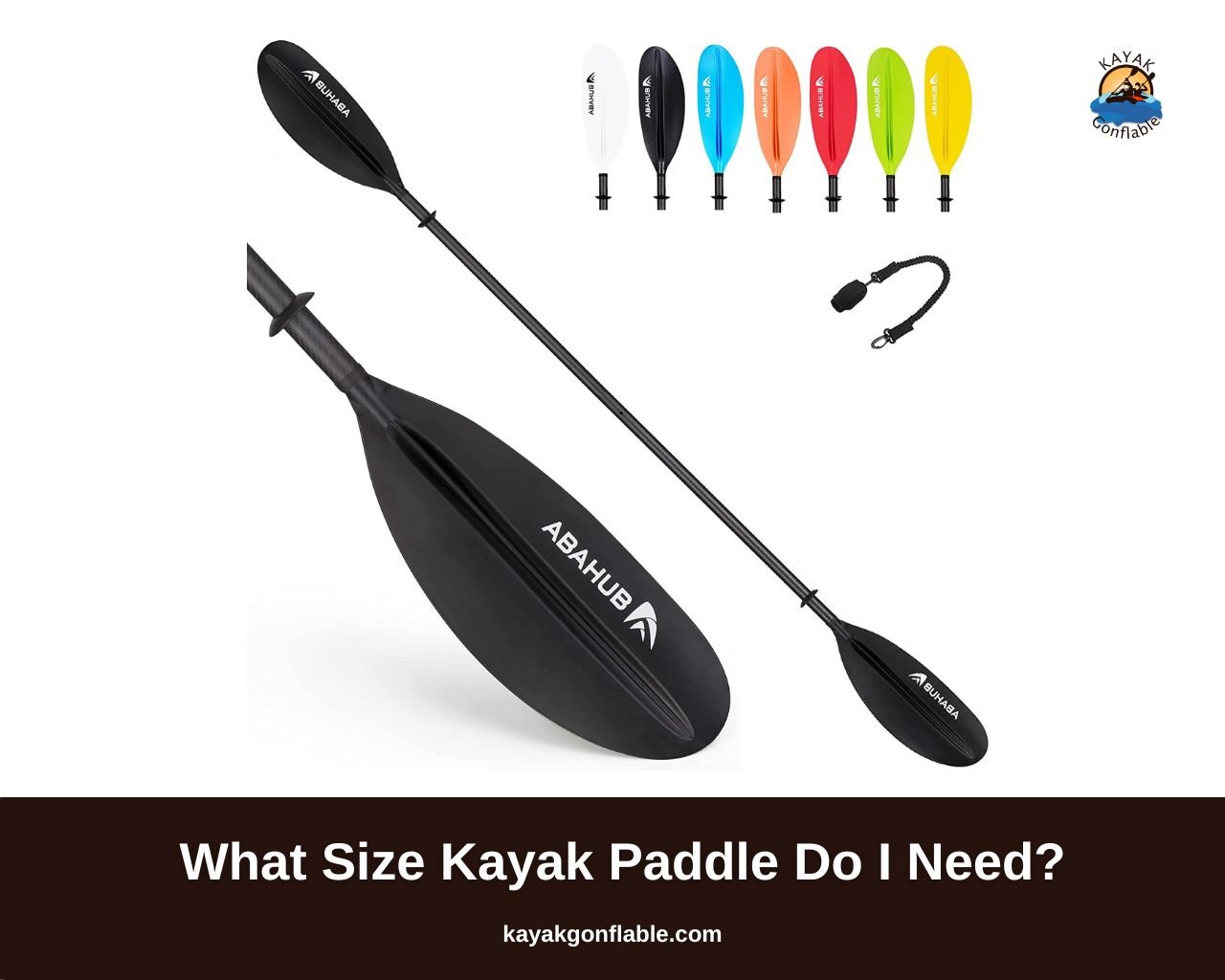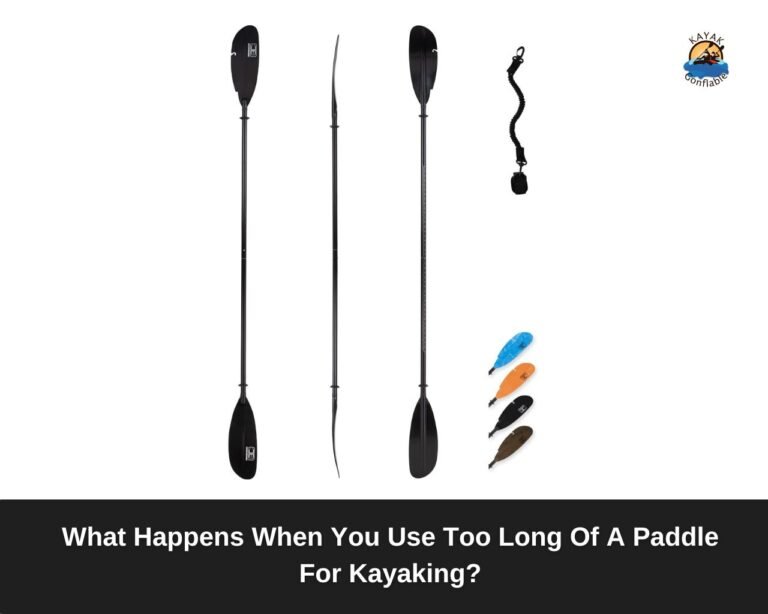What Size Kayak Paddle Do I Need?

Kayaking is a fun paddle sport that involves navigating a narrow watercraft called a kayak with a double-bladed paddle through a water body. As the sport’s popularity increases, more and more people are found on the water testing and being hooked on the sport.
Beginner kayakers eventually want equipment of their own; the first thing that comes to mind is the kayak they desire and plan to purchase. Another important piece of equipment novice kayakers often forget about until later is the paddle they will use for kayaking.
Using the appropriate kayak paddle is essential if you are to enjoy your adventure and conserve your strength. The kayak paddle you will use depends on several factors like your height, kayak width, and the paddling style you employ.
In this article, we give you a guide to choosing the right paddle for you to enjoy your adventures on the water. Read on and enjoy!
Why Is Using The Right Size Kayak Paddle Important?
When you are kayaking, your paddle is one of the most important pieces of equipment that you have. Not only does it help you move through the water, but it can also be used for navigation and stability.
Because of this, kayakers need to be sure that they are using the right size kayak paddle for their height and weight. Using a paddle that is too short or too long can result in an inefficient and tiring paddling experience.
A kayaker’s shoulders, arms, and back should all be in a straight line when paddling. Here are a few reasons why using the right size kayak paddle is important:
- The right paddle size will allow you to paddle with ease and comfort.
- The wrong paddle size will affect your kayak’s track making it difficult to paddle on a straight track and resulting in you moving in a zig-zag pattern
- Using the wrong paddle will affect your stability while kayaking resulting in you having to put more effort into paddling safely.
- Using the wrong paddle will make you get tired quicker especially when touring or paddling for long sessions as it will decrease the efficiency with which you move through the water.
- If the paddle is too short, the kayaker’s body will be angled forward and they will have to reach further to paddle leading to increased stress.
- You will have the deal with handling the extra weight of the paddle if you pick a kayak paddle that is too long.
What Size Kayak Paddle Do I Need?
Generally, kayakers of average size and weight need a 230 cm kayak paddle for optimum paddling experience on the water though the length could vary based on some factors.
The 230 cm kayak paddle is ideal for those who use the low-angle paddling style which is a relaxed, easy-going, and slower paddling style.
A shorter kayak paddle of length 220 cm or 210 cm is ideal for kayakers of average size and weight who use the high-angle paddling style which is a faster and more aggressive form of kayak paddling.
Things To Consider Before Sizing A Kayak Paddle
To choose the right kayak paddle to suit your needs, you have to consider certain factors. The result of analyzing these factors is what ultimately determines which paddle length is best suited for you so they should be considered with care. The factors to consider are given below.
The Paddler’s Height
Your overall and torso heights must be considered in choosing the right kayak paddle. Generally, the taller the paddler, the longer the paddle he will need.
The paddler’s overall height is best used when you are in a hurry or are borrowing a paddle and do not have the luxury of finding a perfect fit.
If you are purchasing a paddle however and have time on your hands, it is best to use your torso height in choosing your paddle or if you so desire, you can use both your overall and torso height in choosing your paddle.
The reason why the torso height is preferred when sizing a kayak paddle is that as we are all built differently, people of the same height will have variations such as the torso length of one being greater than the other.
So, to account for this variation, the torso length is used to choose your kayak paddle.
Width Of The Kayak
The next most important factor is the width of your kayak. Generally, the wider the kayak, the longer the paddle is required to paddle it efficiently so your kayak’s width should always be considered before picking a paddle.
You can obtain the width of your kayak by either measuring it yourself or searching for it on your brand’s website. The width of your kayak should be measured where the frame is widest for accurate measurement.
Though the kayak width is an important criterion, it is irrelevant when choosing a whitewater kayak paddle so only the paddler’s height is considered there.
To give you a general idea if you do not want to search the net or measure it yourself, the lengths and widths of different kayak types are given below.
Your Paddling Style
The angle at which you hold your paddle relative to the water also determines which paddle is best for you.
If you enjoy low-angle paddling, then you will need a longer paddle to navigate your kayak safely through the water without hitting the sides of the vessel with the paddle.
If you like moving fast on the water, then you use the high-angle paddling style and will need a shorter paddle for effective paddling.
The Type Of Kayaking You Engage In
Another important thing to consider is the type of kayaking you plan to do once on the water. The type of kayaking (recreational, touring, or whitewater kayaking) plays a huge role in what paddle size is best suited for you.
Short paddles are most suited for whitewater kayaking as it involves navigating rapids at high speeds. In contrast, longer paddles are needed when touring as they generate more power and will help you easily cover much ground at leisure.
If you want to kayak recreationally, a paddle in between those extremes should do the trick providing enough power to cover much ground at a relaxed pace.
Kayak Paddle Length In Inches
Regardless of your country or the measurement system you use, paddle length is always measured in cm. This makes for a universal way of measuring paddles worldwide with no need for confusion.
For the benefit of those used to the imperial system of measurement, however, paddle lengths in both cm and inches are given below.
Checking the table, you will notice that with every paddle length increase or decrease of 10 cm, about 2 inches are added or removed respectively on each end of the kayak paddle.
While this difference may not amount to much when paddling for a short time, if you are touring or exploring and paddling hours at a time it becomes relevant as the wrong paddle size tires you faster.
How To Size Your Kayak Paddle?
Several ways or guides exist to help you choose the appropriate paddle length for you. They are discussed in detail below.
Hook The Finger Method
The fastest way to choose a kayak paddle is the hook-the-finger method. This method is best used when you are in a hurry or don’t have the luxury of considering all the necessary factors for choosing the right paddle. This method involves two steps.
- First, you get a feel of the paddle to determine if you vibe with it. This is done by holding out your arms in front of you with your elbows bent at 90 degrees in a normal paddling position and holding the paddle with two hands while standing. Your hands should be about two-thirds away from the center of the paddle to the shoulder of the paddle blade. The shoulder of the paddle blade is where the blade meets the shaft. Once holding the paddle this way, you should feel it and decide if it is for you. Before choosing the paddle, however, you should do the height test.
- The second part of this method is the height test. Here you stand the paddle next to you and extending your arms upward to their full length, try to hook the first joint of your fingers over the edge of the paddle. The second part is the most important part and its verdict is what determines if the paddle is ideal for you or if you should make another choice. If you are unable to wrap the first joint of your fingers, you should get another paddle. Also, if you are unable to wrap the first joint of your fingers you should get another paddle.
While this method is indeed fast, its weakness is that it neglects the width of your kayak, your paddling style, and the type of kayaking you will be engaging in. It is thus best used only when you are in a hurry and don’t have time to pick a paddle after considering all appropriate variables.
Paddle Style and Paddle Sizing
There are two styles of kayak paddling.
Low-Angle Style
This form of paddling is done with the paddle only slightly tilted in relation to the water surface. It is a relaxed and easy-going paddle style that is less tiring and suitable for long paddling expeditions.
Low-angle paddling style is mostly used in recreational and touring kayaking. The ideal paddle length for an average low-angle recreational paddler is 230 cm.
It is crucial to keep in mind that the low-angle style of kayak paddling typically requires longer paddles.
You should note however that using the wrong paddle size, particularly one shorter than required to paddle low-angle style could result in you scraping along the side of your kayak with each paddle stroke.
The result is a zigzag effect that affects your tracking and stability so make sure you always use the appropriate paddle.
High-Angle Style
This form of paddling is done with the paddle tilted more towards the vertical in relation to the water surface. This paddling style is faster than the low-angle style and is also more aggressive.
That is why it is best suited for those engaged in whitewater kayaking where speed and strength are required to make the sport more exhilarating and enjoyable.
High-angle paddling style makes use of shorter paddles with stiffer blades to make efficient strokes. An average high-angle recreational paddler would need a paddle with length range of 210 cm to 220 cm for a safe paddling experience.
As with low-angle kayak paddling, using a paddle of appropriate length is essential when high-angle paddling.
If you make use of a longer paddle, it will increase the stress you put on your shoulders while paddling while also making it difficult to control your kayak in the water. Always ensure you use the right paddle for the paddling style you wish to adopt.
Torso Height Paddle Size Guide
While overall height is quite an accurate way of getting an appropriate paddle, torso height is a better and more precise way to find the best kayak paddle for you.
Torso height is the distance from between your legs at the crotch to the tip of your nose and it is best measured from a sitting position.
The reason why torso height is important is that it is what determines how high your arms will be above the sides of your kayak and that height plays a big role in how easy it will be to dip your paddle in the water while kayaking.
The paddle size guide below tells you the best paddle length suitable for you whether you favor low-angle paddling style or high-angle paddling style.
Hands-On Kayak Paddle Sizing Guide
The age-old saying experience is the best teacher once again proves its validity when sizing kayak paddles.
As with verifying your kayak’s measurements (the length, width, and others), the best way to choose a paddle might simply be to go to a good kayak shop and try out different paddles till you get the best one.
Most good kayak shops will be able to tell right off the bat which paddles you should use and if not, they can help you significantly narrow down the list while allowing you to try out different paddles to pick the best one.
Aside from getting to test out the paddle before buying it, going to a good kayak shop is important as, during the demo, they will be able to alert you to any bad paddling habits you might have and advise you on how best to correct it and make the most of your kayaking experience on the water.
Blade Size and Shape
A kayaker’s paddle is their most important piece of equipment. The size and shape of the paddle blade can make a big difference in how well you can move through the water as they have a significant impact on the paddler’s performance.
A blade that is too small will cause the paddler to fatigue more quickly, while a blade that is too large will make it more difficult to control the kayak.
Also, larger blades provide more power and can be helpful for moving through choppy water, while narrower blades are more efficient and easier to control. The shape of the blade also affects the way it performs in the water.
A curved blade creates more resistance or drag than a straight blade, but it also provides more power and control. Paddle blades are available in a variety of sizes and shapes, so it is important to choose the one that is best for you.
Paddle Materials
The kayak paddle is one of the most important pieces of equipment for the sport of kayaking. Choosing the right kayak paddle is thus important for enjoying your time on the water.
Many different materials can be used to make a kayak paddle, but the most common are aluminum, plastic, wood, fiberglass, and carbon fiber. Each material has its own benefits and drawbacks, so it is important to choose the right material for the type of paddling you plan to do.
Carbon fiber kayak paddles are a great option because they are strong, lightweight, and durable making them a popular choice for avid kayakers.
It also has a comfortable grip that will help you stay in control while you’re paddling by providing a smooth responsive stroke. Carbon fiber paddles can be customized to fit each kayaker’s needs.
They are also more expensive than other paddles. A fiberglass kayak paddle is a great choice for those who want a durable and lightweight option. They are often a bit more expensive than other materials, but they are worth the investment as fiberglass is a strong material that can withstand a lot of wear and tear.
These paddles are easy to maneuver and provide plenty of power. They also come in a variety of colors and styles, so you can find the perfect one for you.
Though not as common as they once were, kayak paddles can also be wooden. Wooden paddles are strong and durable and provide a good amount of power while paddling.
Aluminum is a popular material for kayak paddles because it is strong and lightweight. Aluminum paddles are also affordable, making them a popular choice for beginner kayakers. Though lightweight, aluminum paddles are the heaviest of all paddle options and can be tiring to use for long periods.
Plastic kayak paddles are a popular option because they are affordable and durable. They are also lightweight, which makes them easy to maneuver in the water and transport when not in use.
However, they may not be as sturdy as other types of paddles. Plastic paddles are a great choice for beginner kayakers.
The size kayak paddle you need will depend on the width of your kayak, the height of the paddle, your height, and your personal preference.
A kayaker needs a paddle that is around 8 to 10 inches taller than themselves as that will ensure they have the power and control they need to move through the water efficiently.
To choose the ideal paddle, you should make use of the paddle guides provided in this article. If you are unsure what size to get, it is always best to ask a salesperson for help.
Remember that with the right paddle, you will be able to make the most of your kayaking experience so choose wisely. Always employ safe kayaking practices and have fun on the water.












